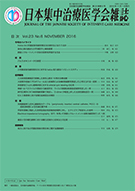Volume 23, Issue 6
Displaying 1-17 of 17 articles from this issue
- |<
- <
- 1
- >
- >|
-
2016Volume 23Issue 6 Pages 617
Published: November 01, 2016
Released on J-STAGE: November 01, 2016
Download PDF (130K)
HIGHLIGHTS IN THIS ISSUE
-
2016Volume 23Issue 6 Pages 619-620
Published: November 01, 2016
Released on J-STAGE: November 01, 2016
Download PDF (210K) -
2016Volume 23Issue 6 Pages 621-622
Published: November 01, 2016
Released on J-STAGE: November 01, 2016
Download PDF (173K) -
2016Volume 23Issue 6 Pages 623-624
Published: November 01, 2016
Released on J-STAGE: November 01, 2016
Download PDF (287K)
REVIEW ARTICLE
-
2016Volume 23Issue 6 Pages 625-631
Published: November 01, 2016
Released on J-STAGE: November 01, 2016
Download PDF (805K)
ORIGINAL ARTICLE
-
2016Volume 23Issue 6 Pages 633-640
Published: November 01, 2016
Released on J-STAGE: November 01, 2016
Download PDF (564K)
CASE REPORTS
-
2016Volume 23Issue 6 Pages 641-646
Published: November 01, 2016
Released on J-STAGE: November 01, 2016
Download PDF (245K) -
2016Volume 23Issue 6 Pages 647-650
Published: November 01, 2016
Released on J-STAGE: November 01, 2016
Download PDF (457K) -
2016Volume 23Issue 6 Pages 651-654
Published: November 01, 2016
Released on J-STAGE: November 01, 2016
Download PDF (4025K) -
2016Volume 23Issue 6 Pages 655-659
Published: November 01, 2016
Released on J-STAGE: November 01, 2016
Download PDF (329K) -
2016Volume 23Issue 6 Pages 660-665
Published: November 01, 2016
Released on J-STAGE: November 01, 2016
Download PDF (846K) -
2016Volume 23Issue 6 Pages 666-669
Published: November 01, 2016
Released on J-STAGE: November 01, 2016
Download PDF (261K)
BRIEF REPORTS
-
2016Volume 23Issue 6 Pages 671-672
Published: November 01, 2016
Released on J-STAGE: November 01, 2016
Download PDF (193K) -
2016Volume 23Issue 6 Pages 673-674
Published: November 01, 2016
Released on J-STAGE: November 01, 2016
Download PDF (246K) -
2016Volume 23Issue 6 Pages 675-676
Published: November 01, 2016
Released on J-STAGE: November 01, 2016
Download PDF (413K) -
2016Volume 23Issue 6 Pages 677-678
Published: November 01, 2016
Released on J-STAGE: November 01, 2016
Download PDF (211K)
INVESTIGATION REPORT
-
2016Volume 23Issue 6 Pages 679-681
Published: November 01, 2016
Released on J-STAGE: November 01, 2016
Download PDF (200K)
- |<
- <
- 1
- >
- >|
